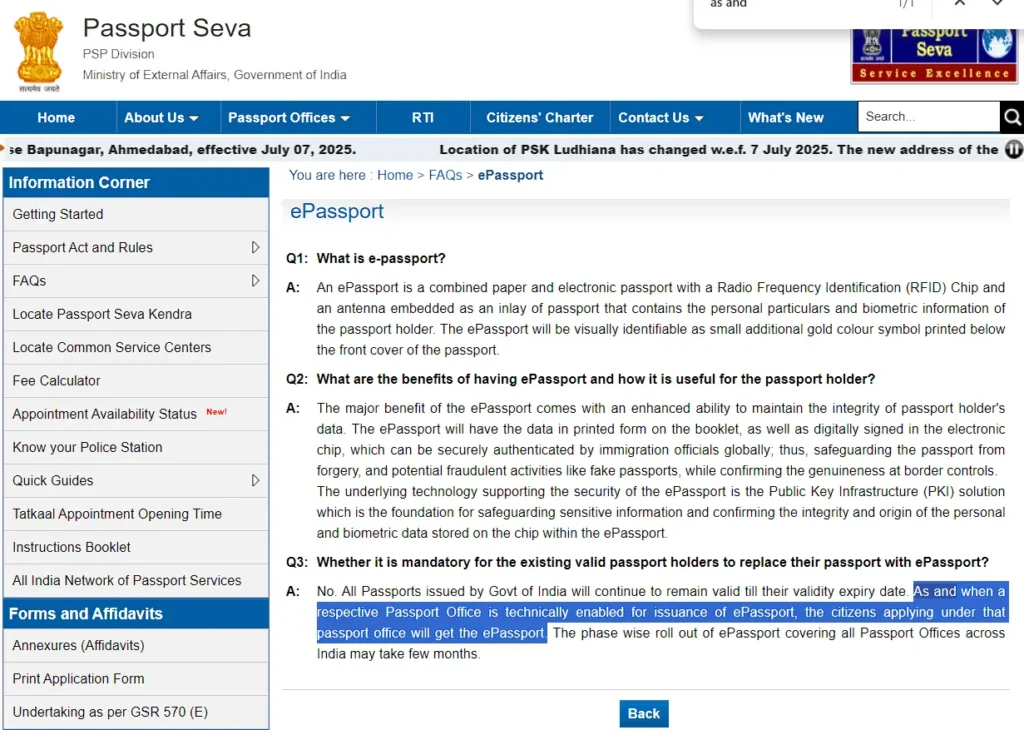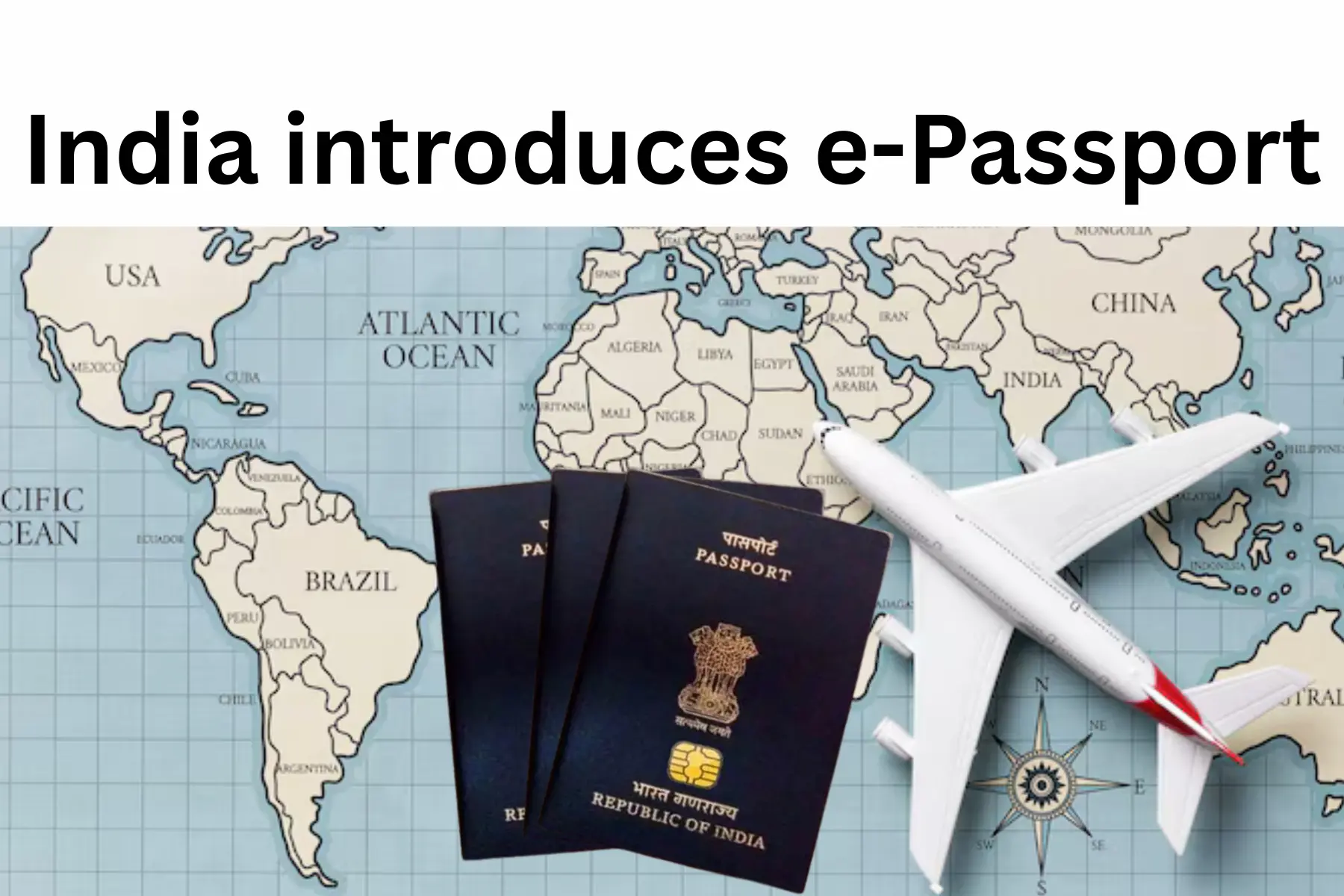New Delhi, July 2025 — In a major step towards digital governance and smarter travel infrastructure, the Government of India has officially launched e-passports as part of its upgraded Passport Seva 2.0 initiative. The announcement was made by External Affairs Minister Dr. S. Jaishankar on the occasion of the 13th Passport Seva Divas, observed on June 24, 2025, marking a new era in secure, tech-enabled international travel for Indian citizens.
The launch of India’s e-passports coincides with the nationwide rollout of the Passport Seva Programme (PSP) Version 2.0, which integrates cutting-edge digital tools to enhance service speed, transparency, and security. Praising the efforts of passport officials and Indian missions abroad, Dr. Jaishankar emphasized that the programme embodies the key pillars of governance — Seva (Service), Sushasan (Good Governance), and Garib Kalyan (Welfare of the Poor) — which are central to building a Viksit Bharat (Developed India).
What Is an e-Passport?
An e-Passport is a modern travel document that combines the traditional paper booklet with advanced digital technology. Unlike regular passports, an e-Passport includes a Radio Frequency Identification (RFID) chip and a tiny antenna embedded as inlay within the back cover. This chip securely stores the passport holder’s biometric details, photograph, and personal data. This microchip technology enables faster and more secure identity verification at immigration checkpoints, both in India and abroad.
To help visually distinguish it from standard passports, every e-Passport also carries a small gold-colored symbol printed below the front cover.
This innovation brings India in line with global passport standards and enables faster, more secure immigration processes at international airports.
Key Features, and benefits of e-Passports
- Embedded Microchip: Stores biometric data such as fingerprints and photo
- Encrypted Data: Protected with international-grade digital signatures
- Faster Immigration: Reduces time spent at immigration counters
- Enhanced Security: Difficult to forge or tamper
- ICAO-Compliant: Follows global passport standards set by the International Civil Aviation Organization
The e-Passport is more than just a digital upgrade — it’s a major step forward in secure, smart travel. Here’s how it enhances your travel experience and strengthens identity protection:
- Enhanced Security & Data Protection
The embedded electronic chip securely stores biometric and personal data, making tampering or duplication extremely difficult. - Faster Immigration & e-Gate Access
ePassports speed up processing at immigration counters, especially at airports equipped with e-gates and automated verification systems. - Reduces Risk of Identity Fraud
Biometric verification makes identity spoofing and passport forgery far more difficult. - Globally Accepted Under ICAO Standards
Indian ePassports comply with international norms set by the International Civil Aviation Organization (ICAO), ensuring global recognition. - Streamlined Verification at International Airports
The contactless chip enables faster and more reliable scanning during border control checks.
Standard Passports vs e-Passports: Key Differences
| Feature | Standard Passports | e-Passports (Electronic Passport) |
|---|---|---|
| Chip Embedded | ❌ No | ✅ Yes – RFID chip embedded on back cover |
| Biometric Data Storage | ❌ Not stored | ✅ Stores photo, fingerprint, and personal details |
| Security Features | Basic (MRZ, watermarks) | Advanced (chip encryption, digital signature, etc.) |
| Forgery Protection | Moderate | High – difficult to clone or tamper with |
| ICAO Compliance | ✅ Yes | ✅ Yes |
| Speed at Immigration | Slower manual checks | Faster – supports e-Gates and automated scanning |
| Look & Feel | Traditional booklet | Similar booklet with chip symbol on front cover |
| Issued In | All Indian Passport Offices | Selected cities under Passport Seva 2.0 (phased rollout) |
| Eligibility | All citizens | Citizens applying from enabled offices |
| Cost | Same as current passport fees | No extra charge currently (as per MEA sources) |
How to Apply for an e-Passport in India
Applying for an e-passport is similar to the standard passport process but with an upgraded delivery format. Here’s how you can apply:
- Visit the official Passport Seva Portal
- Register or log in with your credentials
- Fill in the application for a fresh or reissue passport
- Choose the “e-passport” option if it’s available in your city
- Pay the required fees and schedule an appointment at your nearest PSK (Passport Seva Kendra)
- Attend the appointment for biometric verification
- Once approved, your e-passport will be printed with a chip and delivered via post
Note: e-passports are currently being rolled out in phases, and full availability may depend on your city and regional passport office.
Who Will Receive the New e-Passports?
Initially, new applicants and those applying for passport renewals will receive the updated e-passport format. Over time, the government plans to completely transition from traditional booklets to chip-based passports for all Indian citizens.
Which Cities in India Offer ePassport Facilities Under Passport Seva 2.0 in 2025?
The Indian government’s ePassport initiative, launched under the Passport Seva Programme 2.0, is being implemented in a phased manner across the country. The rollout officially began on April 1, 2024, with a pilot phase in Bhubaneswar and Nagpur.
As of mid-2025, according to multiple credible sources, ePassports are being issued in the following 13 cities under the ongoing pilot phase:
- Nagpur
- Bhubaneswar
- Jammu
- Goa (Panaji)
- Shimla
- Raipur
- Amritsar
- Jaipur
- Chennai (started March 3, 2025)
- Hyderabad
- Surat
- Ranchi
- Delhi
The Ministry of External Affairs has confirmed that the service will gradually expand to additional Passport Seva Kendras (PSKs) and Regional Passport Offices (RPOs) nationwide. A full rollout is expected by the end of 2025.
Should You Replace Your Existing Passport with an ePassport?
No, there’s no need to replace your current passport.
Existing Indian passport holders can continue using their valid passports until they expire — there’s no requirement to exchange them for an ePassport.
The Ministry of External Affairs has confirmed that all passports issued prior to the ePassport rollout will remain valid for international travel until their printed expiry date.
Meanwhile, passport offices across the country are being gradually upgraded to support ePassport issuance under the Passport Seva Programme 2.0. This rollout is being implemented in phases and may take several months.
“As and when a respective Passport Office is technically enabled for issuance of ePassport, the citizens applying under that passport office will get the ePassport,” the official website clarifies.

What Makes This Launch Important?
The e-passport launch isn’t just about convenience — it represents a major transformation in how India handles border security, citizen identity, and global mobility. By adopting chip-enabled passports, India joins countries like the US, UK, and Germany in offering internationally secure travel documents.
According to government sources, the new Passport Seva 2.0 system also includes:
- Real-time application tracking
- Improved data verification
- Enhanced cyber-security protocols
Government’s Vision
External Affairs Minister S. Jaishankar stated, “The introduction of e-passports is a part of our broader vision to deliver citizen-centric services using technology. This step enhances both efficiency and national security.”
In Summary
India’s launch of e-passports is a significant step towards transforming the travel experience of over a billion people. With faster immigration, advanced security features, and a smoother application process, e-passports under Passport Seva 2.0 are set to redefine how Indians travel globally.
Frequently Asked Questions (FAQs) on e-Passports under Passport Seva 2.0
1. How to apply for an e-Passport in India?
2. Is e-Passport available in India?
3. How to know if my passport is an e-passport?
4. Is the Indian passport a biometric passport?
5. How to get a biometric passport in India?
6. How to get an e-passport in India?
7. What is the launch date of e-chip passport in India?
8. Who was the first person to receive an e-passport in India?
9. How many passport offices are there in India?
10. What is the difference between an e-passport and a normal passport?
11. How many passports are issued per day in India?
12. What does an e-passport look like?
13. What is the fee for an e-passport in India?
14. What is the difference between ePassport and regular passport?
15. What is the educational qualification required for an e-passport?
Stay updated with verified news, job alerts, scholarships (India & abroad), and welfare schemes — subscribe to our newsletter and follow us for more!

